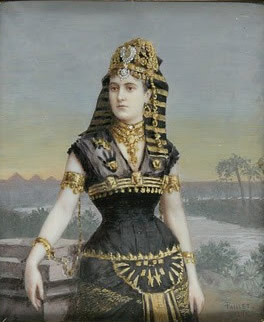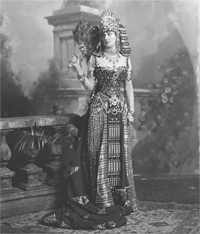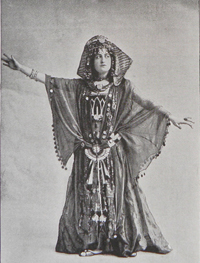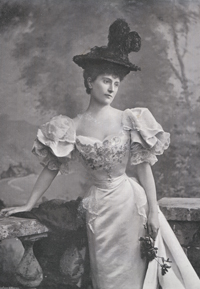Mrs Arthur Paget, later Lady Paget,
The daughter of the wealthy American hotelier, Paran Stevens, who died in 1872 leaving his daughters the fantastic sum of ten million dollars, six years later she married General Rt. Hon. Sir Arthur Henry Fitzroy Paget (1851-1928), a soldier, diplomat and grandson of the 1st Marquis of Anglesey. She was one of a small coterie of American heiresses in the Prince of Wales's set and as a fabulously wealthy member of London society, with a London residence in Belgrave Square, she threw herself with gusto into charitable work - one of the few outlets for the energies of society ladies at the time. Her greatest success was The Masque of Peace and War organised at the Haymarket Theatre in London in February 1900, which raised £7,000 for the widows and orphans of the Boer War. The Lafayette Studio also photographed this event.
For the Ball, Mrs Paget - as one of the three Cleopatras present - commissioned one of the most spectacular and certainly the most expensive costumes from Worth of Paris at a reputed cost of over $6,000. The train is of black crêpe de chine, embroidered with gold scarabs. The bodice, encrusted with gold and diamonds, is held up on the shoulders with straps of large emeralds and diamonds. The square headdress is “one mass of real rubies, emeralds, turquoises, diamonds and pearls” with striped black and gold sphinx-like side pieces studded with diamonds. Crowning her is an ibis headdress, with outstretched wings of diamonds and sapphires. The remainder of the headdress is of uncut rubies and emeralds, all real stones from her own immense collection, surmounted by the jewelled crown of Egypt. She wears round her neck row upon row of necklaces of various gems, reaching to the waist, and a jewelled hem-length girdle. A small diamond asp nestling on her right shoulder give a hint of Cleopatra’s doom. The small Ottoman wedding coins attached to her wrist- and arm-bands are an anachronism. The Lady’s Realm said, rather understatedly, of her costume “black-and-gold always makes its mark among so many brighter colours, and her jewels alone would have made any dress worthy of remark.” With such riches, her closeness to the Prince of Wales and her extravagant literary salons, Mrs Paget had aroused the resentment of some other society ladies. However when she entered the Ball followed by a ‘negro servant’ holding a fan of ostrich feathers over her head, other guests ‘gasped with wonder and astonishment.’ This image was made at the Ball, but not used in the Album which instead included a portrait in costume by the photographer J Thomson of Grosvenor Street which captures Mrs Paget’s delicate waist more clearly as well showing to better effect the gold scarab motif on her train.
|
Click on image to enlarge
|
||||||||||||||
|
|||||||||||||||


 V&A Lafayette Archive
V&A Lafayette Archive
